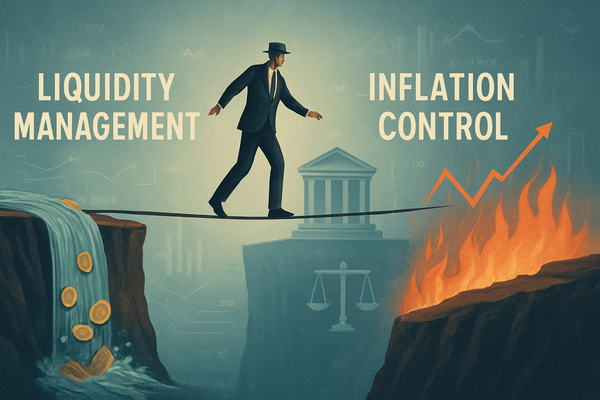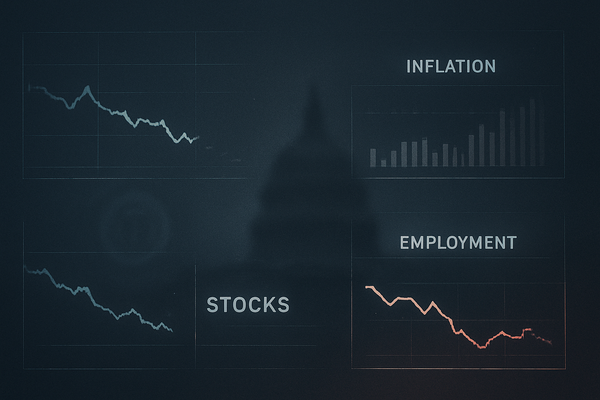The October Phoenix: Markets Soar Back from Volatility's Ashes

As the final trading day of October 2025 draws to a close, financial markets are celebrating a remarkable turnaround, with major indices staging an impressive end-of-month rally. This resilient performance comes despite a tumultuous start to October, characterized by heightened volatility, economic uncertainties, and geopolitical tensions. The powerful rebound has not only restored investor confidence but also signaled a potential shift in market sentiment, prompting analysts to reassess the short-term outlook and identify the driving forces behind this unexpected surge. The immediate implication is a sigh of relief for many portfolios, though questions linger about the sustainability of this late-month bounce.
A Resilient Recovery: Dissecting October's Market Turnaround
The month began with a palpable sense of apprehension, as a confluence of factors – including persistent inflation concerns, hawkish central bank rhetoric, and escalating international trade disputes – pushed major indices like the S&P 500 (NYSE: SPY), Nasdaq Composite (NASDAQ: QQQ), and Dow Jones Industrial Average (NYSE: DIA) into correction territory. Mid-month saw a brief but sharp sell-off, fueled by disappointing quarterly earnings reports from a few bellwether technology companies and a surge in oil prices. However, as the third week progressed, a subtle shift began to emerge.
The turning point appeared to be a series of unexpectedly positive economic data releases, particularly a stronger-than-anticipated jobs report and a slight moderation in core inflation figures, which eased fears of an imminent recession. This was swiftly followed by more dovish comments from several Federal Reserve officials, hinting at a potential pause or even a slowdown in future interest rate hikes. This combination provided the much-needed catalyst for a broad-based rally. Key players in this rebound included institutional investors who saw attractive entry points after the earlier dip, and retail investors who, emboldened by positive news flow, began to re-enter the market. Initial market reactions were overwhelmingly positive, with significant buying pressure observed across various sectors, leading to multiple consecutive days of gains that recouped earlier losses and pushed indices into positive territory for the month.
Corporate Fortunes: Who Wins and Who Loses in a Rebounding Market
A broad market rebound typically creates a diverse landscape of winners and losers, and October's rally was no exception. Technology giants, particularly those in the semiconductor and software-as-a-service (SaaS) sectors, saw significant gains. Companies like NVIDIA (NASDAQ: NVDA) and Microsoft (NASDAQ: MSFT), which had been hit hard by earlier growth concerns, experienced strong bounces as investors rotated back into growth stocks, anticipating a more favorable interest rate environment. E-commerce platforms such as Amazon (NASDAQ: AMZN) also benefited from renewed consumer confidence and easing supply chain pressures.
On the other hand, some defensive sectors and companies that thrive in high-volatility environments saw their relative outperformance wane. Utility companies and certain consumer staples, which often act as safe havens during downturns, experienced more modest gains compared to their growth-oriented counterparts. Companies heavily reliant on stable, predictable cash flows, such as some real estate investment trusts (REITs), might see a temporary dip in investor interest as the broader market offers more attractive risk-adjusted returns. The energy sector, while initially boosted by rising oil prices, saw some profit-taking towards the end of the month as the broader market rally took center stage, with companies like ExxonMobil (NYSE: XOM) consolidating earlier gains rather than leading the charge.
Broader Implications: A Shifting Economic Narrative
This October rebound is more than just a monthly blip; it signals a potential pivot in the broader economic narrative. The market's ability to absorb significant volatility and still finish strong suggests a underlying resilience that many analysts had underestimated. This event fits into a trend where markets are increasingly sensitive to central bank communications and inflation data, with every pronouncement and economic report scrutinized for clues about future policy. The swift recovery could embolden central banks to maintain a data-dependent approach, rather than being swayed by short-term market fluctuations.
The ripple effects extend beyond equity markets. A sustained rally could lead to a 'wealth effect,' boosting consumer spending and potentially easing some of the recessionary fears that plagued the early part of the year. Competitors and partners across industries will be watching closely, as improved market sentiment often translates into easier access to capital for expansion and innovation. Regulatory bodies may also take note, potentially re-evaluating any proposed tightening measures if economic indicators continue to show strength. Historically, strong end-of-month rallies after periods of volatility have sometimes marked turning points, similar to the post-pandemic recovery in 2020 or the bounce-backs seen after significant geopolitical events, indicating that investor psychology can shift rapidly when fundamental conditions appear to improve.
What Comes Next: Navigating the Path Forward
Looking ahead, the short-term outlook appears cautiously optimistic, but vigilance remains key. Investors will be closely watching for confirmation of the positive economic trends that fueled October's rebound, particularly upcoming inflation reports and any further signals from the Federal Reserve. A continued dovish stance from central banks would be a significant tailwind, while any renewed hawkish rhetoric could quickly dampen spirits. Companies may need to strategically pivot, focusing on capital efficiency and robust balance sheets to withstand any potential resurgence of volatility.
In the long term, this rebound could signal the beginning of a sustained recovery, provided that macroeconomic conditions stabilize and corporate earnings continue to surprise on the upside. Market opportunities may emerge in sectors that are still undervalued despite the rally, or in innovative companies poised for growth in a less restrictive economic environment. Potential challenges include the persistent threat of geopolitical instability, the lingering impact of global supply chain disruptions, and the possibility of a renewed inflationary surge. Scenarios range from a continued "melt-up" into year-end, driven by holiday spending and positive sentiment, to a more subdued period of consolidation as markets digest the recent gains.
October's End: A Message of Resilience
October 2025 will be remembered as a month that began with trepidation but concluded with a powerful testament to market resilience. The key takeaway is the market's capacity to absorb negative shocks and stage a robust recovery when underlying economic fundamentals show signs of improvement and central bank policies appear to align with investor expectations. This end-of-month bounce has provided a much-needed boost to investor confidence and suggests that despite ongoing uncertainties, there is a strong appetite for risk when conditions appear favorable.
Moving forward, the market will likely be characterized by a careful balance between optimism and caution. Investors should continue to monitor key economic indicators, corporate earnings reports, and central bank communications for signals about the sustainability of this rally. While the immediate future appears brighter, the lessons from earlier in October remind us that volatility is an ever-present factor. The focus for the coming months will be on identifying companies with strong fundamentals that can thrive in a dynamic economic landscape, and remaining agile in portfolio management to adapt to evolving market conditions.
This content is intended for informational purposes only and is not financial advice



